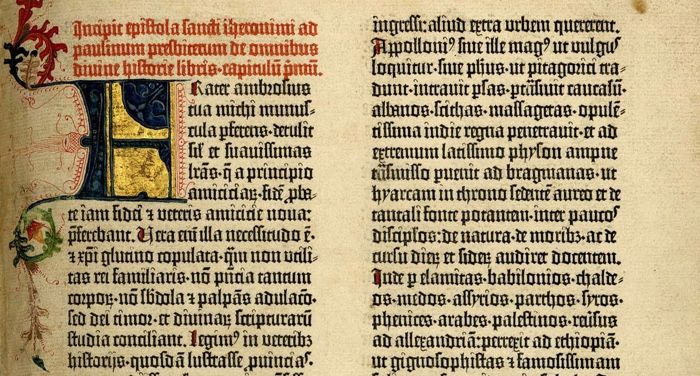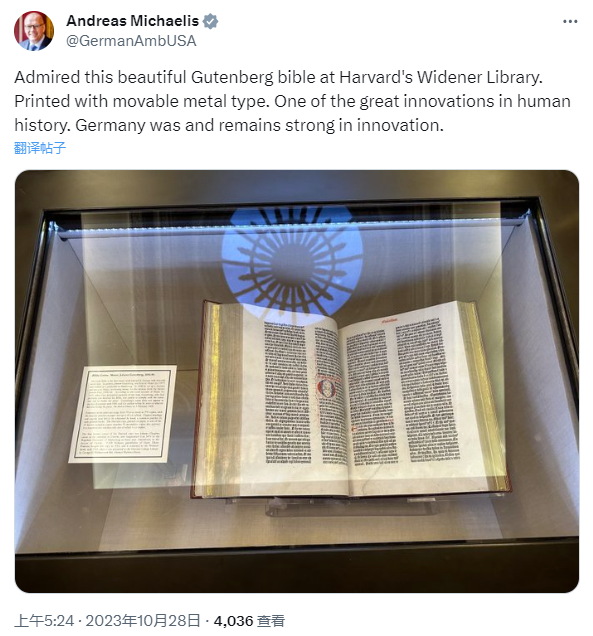《古腾堡圣经》(又称42行圣经)因是欧洲使用可移动金属活字印刷的第一部重要书籍而具有历史意义。其由约翰内斯·古腾堡于1455年至1456年左右印刷,标志着印刷历史上的一次革命。以下是《古腾堡圣经》与后来版本的圣经之间的一些关键区别:

- 印刷技术:
- 古腾堡圣经: 使用可移动金属活字印刷,是当时一项突破性的创新。每页有42行,整个过程涉及为每个字符铸造单独的金属活字并组装它们进行印刷。
- 后来版本: 随着技术的进步,后来版本的圣经,特别是在工业印刷时代,采用了更高效的印刷方法,如使用印刷机和后来的数字印刷技术。
- 历史意义:
- 古腾堡圣经: 作为使用可移动活字印刷的第一本重要书籍,具有巨大的历史意义。它在印刷术在欧洲传播中发挥了关键作用。
- 后来版本: 虽然后来版本的圣经可能没有同样的历史重要性,但它们受益于古腾堡的印刷技术创新,使其更广泛地可获得。
- 可获得性:
- 古腾堡圣经: 数量有限;约生产了180份副本,而今只有几十份幸存。这使其变得更为珍贵。
- 后来版本: 随着印刷技术的发展,圣经变得更加普遍,各种翻译和版本迎合了不同语言和宗教偏好。
- 语言和翻译:
- 古腾堡圣经: 主要是拉丁语,当时是学术和宗教文本的通用语言。
- 后来版本: 随着圣经不断被翻译成众多语言,后来的版本以多种语言面向不同的受众,促进了广泛传播。
- 文化影响:
- 古腾堡圣经: 象征着文化和技术的变革,标志着印刷书籍和大众传播时代的开始。
- 后来版本: 反映了不断发展的文化、宗教和语言多样性,各种翻译和解释迎合了各种教派和信仰。
总体而言,古腾堡圣经因其在印刷历史上的开创性角色而脱颖而出,而后来版本的圣经则反映了几个世纪以来技术、可获得性和文化多样性的进步。

The Gutenberg Bible, also known as the 42-line Bible, holds historical significance as the first major book printed using movable metal type in Europe. Its printing by Johannes Gutenberg around 1455-1456 marked a revolutionary moment in the history of printing. Here are some key differences between the Gutenberg Bible and later versions of the Bible:
- Printing Technology:
- Gutenberg Bible: Printed using movable metal type, a groundbreaking innovation at the time. Each page had 42 lines, and the entire process involved casting individual metal types for each character and assembling them for printing.
- Later Versions: With technological advancements, subsequent versions of the Bible, especially in the era of industrial printing, utilized more efficient printing methods, such as the use of presses and later digital printing technologies.
- Historical Significance:
- Gutenberg Bible: Holds immense historical significance as the first major book printed with movable type. It played a pivotal role in the spread of printing across Europe.
- Later Versions: While later versions of the Bible may not have the same historical importance, they benefited from the printing advancements pioneered by Gutenberg, leading to wider accessibility.
- Accessibility:
- Gutenberg Bible: Limited in quantity; approximately 180 copies were produced, and only a few dozen survive today. The scarcity adds to its value.
- Later Versions: With the evolution of printing technology, Bibles became more widely available, and various translations and editions catered to diverse linguistic and religious preferences.
- Language and Translation:
- Gutenberg Bible: Primarily in Latin, the common language of scholarship and religious texts during that era.
- Later Versions: As the Bible continued to be translated into numerous languages, subsequent versions were available in languages accessible to diverse audiences, contributing to widespread dissemination.
- Cultural Impact:
- Gutenberg Bible: Symbolizes a cultural and technological shift, marking the beginning of the age of printed books and mass communication.
- Later Versions: Reflect the ongoing cultural, religious, and linguistic diversity, with numerous translations and interpretations catering to various denominations and beliefs.
In summary, the Gutenberg Bible stands out for its pioneering role in the history of printing, while later versions of the Bible reflect advancements in technology, accessibility, and cultural diversity over the centuries.




